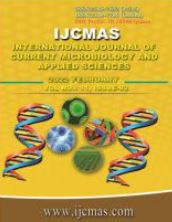


 National Academy of Agricultural Sciences (NAAS)
National Academy of Agricultural Sciences (NAAS)

|
PRINT ISSN : 2319-7692
Online ISSN : 2319-7706 Issues : 12 per year Publisher : Excellent Publishers Email : editorijcmas@gmail.com / submit@ijcmas.com Editor-in-chief: Dr.M.Prakash Index Copernicus ICV 2018: 95.39 NAAS RATING 2020: 5.38 |
Fish known as source of protein and the number of pathogenic bacteria that cause food borne zoonoses such as Escherichia coli (E. coli) as an important contaminants to fish and its products, also investigate some risk factors associated with infection. One hundred and fifty tissue samples (gill, liver and kidney) were taken from 50 different breed of fish (Synodontis schall, Tetraodon lineatus, Oreochromis niloticus, Bagrus bayad and Lates niloticus) for bacteriological diagnosis and conventional PCR was applied confirmation. The risk factors recorded were age, sex, breed, body weight and body condition. The results revealed that the common lesions were local haemorrhage at gill cover and lower jaw with abdominal swelling. Bacteriologically 44(29.3%) samples were positive to the organism. The distribution of E.coli in the gill was 13(29.5%), liver 14(31.8%) and kidney 17(38.7%) organism. When using PCR obious clear single band was appeared for isolated E.coli. The following risk factors showed association with E.coli infection in the univariate analysis under significant level (P-value ≤ 0.25) were age (0.00), breed(0.041) and body weight (0.004).When using multivariate analysis the age of fish was confined to the infection. In conclusion fish contamination from the surrounding and generally young fish are more susceptible to infection by E.coli. PCR is rapid and realistic tool for diagnosis of the infection in fish.
 |
 |
 |
 |
 |